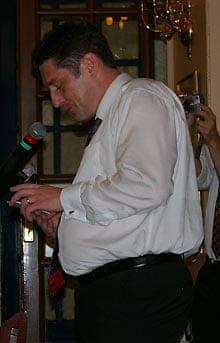When I hauled myself across the finish line of the London Marathon on Sunday I was a face in the crowd – one of more than 36,000 runners, all of us somehow united through a solitary challenge.
In the toughest moments of the race, when I thought I couldn’t push myself any further, I was carried along on a wave of cheers, drumming and samba – by the hundreds of spectators who called out “Come on Nick!” (I definitely recommend writing your name on your top – those spurts of energy when it catches you at a low have got to be worth a minute or two), by the kids holding out their hands to get high-fived and by my wife and son, who turned out again to support me.
The incredible atmosphere, the outpouring of positive energy and a final, desperate attempt at a sprint got me across the line in 2hr 59min 46sec – inside my target with just 13 seconds to spare.
I’m under no illusions. Sub-3 is an arbitrary target and nothing special – 1,300 runners finished in front of me and many clubs have marathoners with PBs in the 2:40s or below. But it’s fast enough that ordinary mortals (especially those in their 40s) can’t achieve it without applying themselves seriously to a training schedule – and it means that for the foreseeable future, my finish time at least starts with the same number as those of the fastest runners in the world, which is nice.
For me personally, it also marks a key point in a lengthy transformation from 40-a-day chain-smoker and 18-and-a-half stone desk-bound office worker who hadn’t taken part in any sport in 15 years, and whose daily diet once consisted of nothing but fry-ups, Snickers bars and Guinness, to a ‘runner’.

I first started running in 2004, spurred into action by the death of my father from cancer at the not-so-ripe age of 48 – seven years after I met him for the first time – and a series of blackouts. Rather than start a lifelong course of statins as prescribed by my doctor, I vowed to get fit and cut my blood pressure naturally.
Ignoring the scepticism of my GP and friends, I finished off my final packet of Drum rolling tobacco, whacked on the nicotine patches and starting hitting the local park for a daily 10-minute jog. After years of inactivity I guess it’s no surprise that within a month my knees were so painful and swollen I couldn’t walk.
A few weeks of rest and a switch to training exclusively on grass sorted that out, and after six months I could jog for half an hour – the time at which running friends assured me the endorphins kicked in (they did, kind of, but the pleasure wasn’t really there yet – it would come, though. I didn’t get a London ballot place, so in the spring of 2005 I ran the Paris marathon in 4hr 20min – a steady 10 minutes a mile pace.
Great … job done, I thought. So I stopped. In what may serve as a cautionary tale to one-off marathoners, the training schedule that got me to the finish on the Champs-Élysées also got me used to consuming about 4,000 calories a day. A marriage, a mortgage and a baby later I was tipping the scales at 18st 9lb and had reached the stage where I had genuinely convinced myself that a KFC Wicked Zinger meal was a healthy option because it contained white rather than red meat.
Keen not to repeat my family history and to be there for my son as he grew up, I came up with a new marathon plan – and this time, inspired by Haruki Murakami’s book What I Talk About When I Talk About Running, I decided the change would be permanent.
Four marathon training schedules back to back helped me shed four-and-a-half stone and get in shape for the Polar Circle marathon in Greenland – a high-carbon footprint, birthday extravagance which whetted my appetite for more – where someone irresponsibly suggested aiming for a sub-3 marathon.
Another year of training saw me lining up in Greenwich last year and finishing in a time of 3hr 2min – so this year I wasn’t taking any chances.
I trained for 2:55 rather than 3:00, bought some lighter shoes and a GPS watch, doubled the number of speed sessions and pushed my weekly mileage from 55 to 70. At times, the schedule I got from Pete Pfitzinger’s Advanced Marathoning book felt like overkill – but on an unexpectedly hot day last weekend I needed every bit of strength and stamina built by his training plan, and I’m thankful I didn’t cut too many corners.
The worst thing about running a marathon for me is the feeling of anticlimax after the race, when the certainty, focus and direction of the past few months disappears. The solution, of course, is to find a fresh target – completing the 100km CCC race in the Alps is my goal for this year (via the Welsh 1,000m Peaks and the Race to the Stones) – and there’s a vague aspiration to tackle a 100-miler in 2014.
A back-of-the-envelope calculation shows 180 steps a minute means 10,800 an hour – so I reckon five or six hours a week over the three-and-a-half years since I started running for the second time means I’ve taken around 10 million steps.
Over that time, what started off as a way to lose weight has become an essential part of my life – a stress-beater, a therapy – some may say an obsession, or even a mid-life crisis. But, above all, it has been a pleasure. I can honestly say that, apart from the first boring and painful six months, I’ve enjoyed every step.
Source: Read Full Article
